Monday, December 3, 2018, 5 pm
The History and Science of Paper in Manuscripts of Central Asia
Agnieszka Helman-Ważny, University of Hamburg & University of Warsaw
180 Doe Memorial Library
UC Berkeley
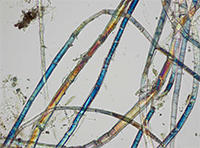
Manuscripts from the Silk Road have been used as a key source in the study of religions, literature, and the cultural history of Central Asia. However, they have hardly ever been viewed as artifacts in their own right. As one of the most important physical features of a manuscript, paper serves as a means to distinguish one type of manuscript from another, and can help to determine the origin of a manuscript. This lecture, based on selected collections of paper and manuscripts found in the caves of Western Nepal, Tibet and Central Asia, surveys a variety of analytical techniques in comparison to codicological methods traditionally applied to manuscript studies. By broadening the scope of methods and ways of thinking, we may gain greater precision of temporal and regional attribution of excavated artifacts.
Agnieszka Helman-Ważny (Centre for the Study of Manuscript Cultures, University of Hamburg, and the Department of Books and Media History, Faculty of Journalism, Information and Book Studies, University of Warsaw) is a paper scientist and the author or co-author of four books and over forty scholarly articles.
Co-sponsored by the Center for Buddhist Studies.
Wednesday, October 24, 2018, 5pm
Buddhist Textiles Along the Silk Road
Mariachiara Gasparini, University of California Riverside
180 Doe Memorial Library
UC Berkeley
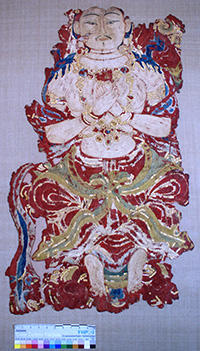
In the field of Buddhist Studies textual sources provide a fundamental ground to analyze and compare philosophical and religious contexts developed in various geographic areas of the larger Asian continent. However, as a non-verbal form of communication, textile material evidence and visual representation may offer a different intercultural perspective that clarifies Buddhist rituals, and monastic and laic lifestyles along the Silk Road. Developed from a larger ontological and interdisciplinary study that will be published in 2019, this paper presents a few case studies from the Turfan Textile Collection in the Museum of Asian Art in Berlin, and the Dunhuang Textile Collections in the British Museum and the Victoria and Albert Museum in London.
Mariachiara Gasparini received her Ph.D. in Transcultural Studies: Global Art History from Heidelberg University, Germany. Her research focuses on Central Asian textiles, material culture, wall painting, artist's praxis, and Sino-Iranian and Turko-Mongol interactions. She is currently Visiting Assistant Professor of Asian Art at the University of California Riverside. Her book Transcending Patterns: Silk Road Cultural and Artistic Interactions through Central Asian Textiles (7th-14th century) is forthcoming (Hawai'i 2019).
Sunday, October 7, 2018, 3pm
Delhi to Damascus
Sandeep Das and the HUM Ensemble
Hertz Hall
UC Berkeley

Tabla virtuoso and Grammy Award-winning member of the Silkroad Ensemble, Sandeep Das celebrates the vibrant cultural heritage shared by India and Syria in his latest project with the thrilling HUM Ensemble. Driving strummed strings, pulsating drums, hypnotic bowed drones, and soaring raga and maqam melodies rooted in Sufi poetry come together to connect ancient civilizations with modern virtuosity in Delhi to Damascus. Das is joined by Syrian oud master Issam Rafea, Indian vocalist and sarangi player Suhail Yusuf Khan, and sitar player Rajib Karmakar to explore centuries of classical and folk music that emerged along the winding trade road from Jaisalmer in India to Damascus in Syria.
The performance will be preceded by a lecture demonstration, at 2:00 pm. In this special pre-performance event, presented in association with the Tang Center for Silk Road Studies, the artists will discuss musical traditions shared across cultures. The demonstration is free to ticket holders.
More information available here.
Tickets start at $54 and are available here.
Friday, September 28, 2018, 6pm
2018 Tang Lecture
Illustrations of the Parinirvāṇa Cycle in Kucha
Monika Zin, University of Leipzig, Germany
Toll Room, Alumni House
University of California, Berkeley
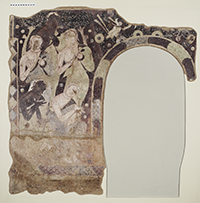
At least 100 caves in Kucha contain (or once contained) murals depicting scenes connected with the Buddha's death. The paintings are typically located in the rear part of the caves, in corridors behind the Buddha in the main niche. The illustrations begin with the episodes from the Buddha's last journey and end with the first council in Rājagṛha. It is solely through comparative analysis of the representations that it becomes possible to discern their programme. Through this programme, we discover the local beliefs these illustrations mirror, and the literary sources they illustrate. Interestingly, the arrangement of the murals in the corridors often follows the principles of symmetry, and not the chronology of the narrative, as if to create a “holy space” rather than to illustrate a chronology of events.
An expert on Indian and Central Asian Art, and Indian drama, Monika Zinbegan her academic career at the Jagiellon University in Cracow, Poland, in Theater Studies and Polish Language and Literature (M.A. in 1981). This was followed by a doctorate in Indology and Indian Art and post-doctoral studies (habilitation) in Indology at the LMU in Munich. In 2000, she joined the Department for Indology at the LMU Munich as an Associate Professor and also held a position as a Lecturer in Buddhist Art and Literature in the Department for Indology and Central Asian Sciences at the University of Leipzig from 2005 to 2008. From 2010-2014, she was a Visiting Professor in the Department of Art History at the FU Berlin. She is currently a professor at the University of Leipzig working on a project entitled “Buddhist Murals of Kucha on the Northern Silk Road.”
Co-sponsored by the Center for Buddhist Studies.
Thursday, September 27, 2018, 5pm
Thangkas, Texts, and the Silk Route
Ann Shaftel, Dalhousie University
180 Doe Memorial Library
UC Berkeley
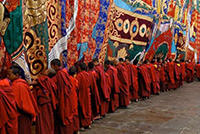
In a richly illustrated presentation on the challenges of applying conservation science to Buddhist sacred thangkas and texts, Ann Shaftel will include a discussion of the relationship between thangkas and texts, and the evolving function of thangkas in Buddhist philosophy, textural history and culture. The images accompanying her talk will feature Silk Route thangkas, and others from her 48 years of work in monasteries and museums.
Ann Shaftel's work is at the forefront in the field of thangka conservation worldwide. She is a renowned teacher of international workshops on the conservation of Buddhist treasures—in the US, Canada, Europe, Bhutan, Nepal, India and China. She is a Fellow of the American Institute for Conservation, and a Fellow of the International Institute for Conservation. Ann's international work in Treasure Caretaker Training won the prestigious Digital Empowerment Foundation's Chairman's Choice award.
Co-sponsored by the Center for Buddhist Studies.
Friday-Saturday, May 4-5, 2018
Across the High Seas: Cross-Cultural Encounters in the Indian Ocean Littoral
Conference
180 Doe Library
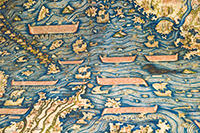
In the public imagination, the Silk Roads has become a catchall phrase to describe the overland and maritime exchange networks crisscrossing Eurasia, from the first Millennium BCE through (at least) the medieval period.
Although distinct patterns of long-distance exchange are attested to as early as the Bronze Age when, for example, lapis lazuli was exported by land and sea from the Indus Valley to the Near East, textual and archaeological research points to the turn of the Common Era as the period when the first institutionalized networks of maritime trade connecting what is now Europe to Africa and Asia were developed, concomitant with existing overland routes. These networks were defined by increased levels of interaction alongside the exchange of goods and ideas.
As scholars continue to explore and uncover particularities of the Eurasian networks, evidence suggests there is a need to reconfigure the monolithically imagined Silk Roads into smaller fragmented webs of economic, political and cultural exchanges, to locate those networks in time and space, and to study them as functioning both independently and interdependently.
This conference will highlight recent archaeological and historical research on some of the networks that operated across and around the Indian Ocean, and focus on the spatial configurations specific to maritime trade and the transformations of cultural and material artifacts as a result of those exchanges.
May 4 | 9:30am - 12:00pm
Spaces, Places, and Things: Spatiality in early Indian Ocean exchange
Eivind Heldaas Seland, University of Bergen
Berenike's Role in the Ancient Maritime Silk Road Based on Results of Recent Excavations
Steven Sidebotham, University of Delaware
Ancient Ties between China and East Africa
Chapurukha Kusimba, American University
May 4 | 2:00pm - 4:30pm
Networks of Trade in the Indian Ocean: Spatial analysis in exchanged goods and cultural appropriation
Ariane de Saxcé, CNRS
Roman Glass in Asia: Where, When and Why
James Lankton, UCL
Indian Ocean Trade through Buddhist Iconographies
Osmund Bopearachchi, CNRS/UC Berkeley
May 5 | 9:30am - 12:30pm
Voyage and shipbuilding during the Maritime Silk Route's period
Jun Kimura, Tokai University
Reconstructing Demographics, Social Hierarchies and Ethnicity in Early Second-Millennium AD Port-Cities in the Malacca Straits Region
Derek Heng, Northern Arizona University
Theorizing Maritime Space through Premodern Sino-Islamic Connections
Hyunhee Park, John Jay College of Criminal Justice
Thursday, March 8, 2018, 5pm
Migrants, Monks, and Monasteries: Toward a History of South China Sea Buddhism
Jack Meng-Tat Chia, University of California, Berkeley/National University of Singapore
180 Doe Memorial Library
The event is co-sponsored by the Tang Center for Silk Road Studies and the Center for Buddhist Studies
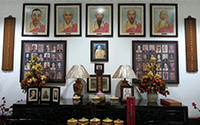
Chinese migration since the nineteenth century have led to the spread of Buddhism to maritime Southeast Asia. Recently, scholars of Buddhism and historians of Chinese religions have begun to consider the connected history of Buddhism in China and Southeast Asia, using Buddhist records, epigraphic sources, as well as oral history interviews. In this talk, I explore the transregional Buddhist networks connecting Southeast China and the Chinese diaspora from the nineteenth century to 1949. I discuss how new patterns of Buddhist mobility contributed to the circulation of people, ideas, and resources across the South China Sea. I show that, on the one hand, Buddhist monks and religious knowledge moved along these networks from China to Southeast Asia, while money from wealthy overseas Chinese was channeled along the networks for temple building in China; on the other hand, Buddhist monks relied on the networks to support China's war effort and facilitate relocation to Southeast Asia during the Sino-Japanese War.
Jack Meng-Tat Chia is a Senior Tutor in the Department of History at the National University of Singapore and currently a Postdoctoral Scholar at the Center for Buddhist Studies, University of California, Berkeley. Born and raised in Singapore, he received his MA in East Asian Studies from Harvard University, and his PhD in History from Cornell University. He is currently working on his book manuscript, entitled Diaspora's Dharma: Buddhism and Modernity across the South China Sea. This book seeks to contribute to our understanding of the connected history of Buddhism in China and Southeast Asia.
Wednesday, February 21, 2018, 5pm
Reconfiguration of Ceramic Production and Trade in China at the Threshold of Global Trade:
An Archaeological Perspective
Min Li, University of California, Los Angeles
180 Doe Memorial Library

Taking archaeological ceramics from production, transportation, and consumption sites during the 13th to 17th century, this paper examines the changing configuration of ceramic production and trade on Chinese coast during the critical transition from the Asiatic Trade Network to the beginning of early global trade. I will explore how potter communities in China linked to emerging maritime commercial enterprise adapt to the new demands and circumstances generated by early global trade and the expansion of Iberian colonial Enterprise by making innovations to their centuries old technological traditions. It will also explore the diverse ways that trade ceramics were incorporated into the local material culture as unfamiliar designs were brought to the potter communities in China and Chinese exports were brought to unfamiliar places along the global trade network.
Li, Min (Ph.D, University of Michigan, 2008) is an associate professor of East Asian archaeology with a joint appointment at Department of Anthropology and Department of Asian Languages and Cultures at UCLA. His archaeological research spans from state formation in early China to early modern global trade network. He is also co-director of the landscape archaeology project in the Bronze Age city of Qufu, China. His first book Social Memory and State Formation in Early China is currently in production with Cambridge University Press and is scheduled to be released in March, 2018. He is working on his second book on the origin and dynamics of the Shang state in Bronze Age China.

